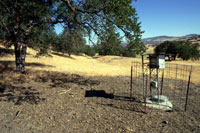Historical Note
In October 1965, the US Coast and Geodetic Survey Strong-Motion Network (USC&GS), now operated by the USGS National Strong-Motion Project (NSMP), installed several strong motion seismographs just south of Parkfield. Through enormously good luck, these instruments provided recordings of the M6 Parkfield earthquake that occurred just eight months later, in June of 1966. Immediately following the earthquake, Jerry Eaton, USGS, installed the first dense network of seismographs at Parkfield to record the quake's aftershocks. This was followed by the installation of telemetered stations on the San Francisco Peninsula in 1967.
To record earthquakes, seismologists place electro-mechanical devices called seismometers along faults, sometimes at the earth's surface and sometimes in drill holes a few hundred meters deep. When the ground shakes due to an earthquake, seismometers convert the motion into an electrical signal, which is recorded and saved, usually by a computer. As part of the Parkfield Earthquake Experiment, a large number and variety of seismic instruments have been installed there, some to monitor the seismicity leading up to the next Parkfield earthquake and some to document the strong ground motion from that earthquake when it occurs.
Permanent Seismic Network
Of the seismic stations operated by USGS Northern California Seismic Network, 18 are located within 25 km of Parkfield. The data are telemetered to Menlo Park, CA, where the earthquakes' location and magnitude are determined within 3-5 minutes of their occurrence. The network is well suited to the rapid detection and recognition of potential M>0.8 foreshocks at Parkfield.
As part of this network, data from thirteen 3-component force balanced accelerometers (FBA), located within 10 km of the San Andreas fault, are telemetered to Menlo Park in real-time. The purpose of these instruments is to allow scientists in Menlo Park to rapidly establish the location and magnitude of M>3.5 potential Parkfield foreshocks. Earthquakes of this size would overdrive the more sensitive NCSN and borehole seismographs.
High Resolution Borehole Seismograph Network (HRSN)
Nine 3-component seismometers have been installed in boreholes near Parkfield, in cooperation with the University of California, Berkeley and Duke University, to provide high-gain, high-frequency records of magnitude -0.25 and larger shocks. A digital radio telemetry system (500 samples/second, 16-bit resolution) records the data from the borehole seismographs at a central site.
Parkfield Small Aperture Array (UPSAR)
The USGS installed a differential seismograph array consisting of 14 seismometers distributed in the shape of a "T," with each arm of the T about 1 km long. This specialized array is designed to record data useful for both earthquake prediction and strong ground motion studies. The array will be used as a "seismic antenna" to study the details of the radiation of seismic energy from small shocks in the Parkfield area and the details of rupture along the fault during the anticipated magnitude 6 main shock.
GEOS
An array of thirteen 3-component force-balance accelerometers (FBA) and seismometer sensors were installed near Parkfield. The data are recorded on GEOS (the General Earthquake Observation System), a broad-band, high dynamic range system developed by the USGS. When triggered, GEOS records 6 channels of data at 200 samples/second each channel with 16-bit resolution. The data will provide high-resolution details of the main shock, large foreshocks, and large aftershocks.
Turkey Flat Strong-Motion Array
The Turkey Flat Strong-Motion Array was designed to augment the Parkfield Strong Motion Array and to record data needed to compare various ground response estimation methods. Given the same geotechnical conditions (such as crustal structure and earthquake rupture), do different methods of predicting ground response agree? How do the calculated responses compare to the recorded response? Seven US and two Japanese geotechnical firms conducted field surveys, laboratory analyses, and interpretative services in order to provide an accurate description of the geology at Turkey Flat. Four holes were drilled to depths of 12-24 m (40-80 ft). Lithologies, attenuation, densities and P- and S-wave velocities were logged.
Parkfield Strong Motion Array
An array of 47 strong motion seismographs is installed at Parkfield by the California Division of Mines and Geology. The array was set up to study the attenuation of seismic waves as they travel away from the source, and to study the influence of local geology on the amplitude of ground shaking.
Rupture Video

A video camera is permanately set up on the San Andreas fault at Carr Hill. The camera will start recording when it is triggered by mechanism response from instruments measuring seismicity at Middle Mountain.
 Jump to Navigation
Jump to Navigation